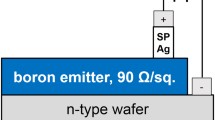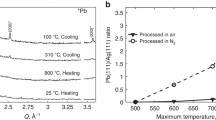Abstract
Formation of an Ohmic contact requires a suitable firing temperature, appropriate doping profile, and contact dimensions within resolution limits of the screen-printing process. In this study, the role of the peak firing temperature in standard rapid thermal annealing (RTA) six-zone conveyor belt furnace (CBF) and two inexpensive alternate RTA systems [a custom-designed, three-zone, 5″-diameter quartz tube furnace (QTF) and a tabletop, 3″-diameter rapid thermal processing (RTP)] has been investigated. In addition, the role of sheet resistance and contact area in achieving low-resistance ohmic contacts has been examined. Electrical measurements of ohmic contacts between silver paste/n +-emitter layer with varying sheet resistances and aluminum paste/p-doped wafer were carried out in transmission line method configuration. Experimental measurements of the contact resistivity (ρ c) exhibited the lowest values for CBF at 0.14 mΩ cm2 for Ag and 100 mΩ cm2 for Al at a peak firing temperature of 870°C. For the QTF configuration, lowest measured contact resistivities were 3.1 mΩ cm2 for Ag and 74.1 mΩ cm2 for Al at a peak firing temperature of 925°C. Finally, for the RTP configuration, lowest measured contact resistivities were 1.2 mΩ cm2 for Ag and 68.5 mΩ cm2 for Al at a peak firing temperature of 780°C. The measured contact resistivity exhibits strong linear dependence on sheet resistance. The contact resistivity for Ag decreases with contact area, while for Al the opposite behavior is observed.
Similar content being viewed by others
References
P.N. Vinod, J. Electron. Mater. 42, 2905 (2013).
Y. Yang, S. Seyedmohammadi, U. Kumar, D. Gnizak, E. Graddy, and A. Shaikh, Energy Procedia 8, 607 (2011).
A. Ebong and N. Chen, in 9th International Confernce on High Capacity Optical Networks and Emerging/Enabling Technologies (2012), pp. 102–109.
G. Grupp, D. Biro, G. Emanuel, R. Preu, F. Schitthelm, and G. Willeke, in 31th IEEE Photovoltaic Specialists Conference (2005), pp. 1289–1292.
D.K. Schroder and D.L. Meier, IEEE Trans. Electron Devices ED-31, 637 (1984).
C.Y. Chang, Y.K. Fang, and S.M. Sze, Solid State Electron. 14, 541 (1971).
D.L. Meier and D.K. Schroder, IEEE Trans. Electron Devices ED-31, 647 (1984).
I.B. Cooper, A. Ebong, B.C. Rounsaville, and A. Rohatgi, IEEE Electron Device Lett. 31, 461 (2010).
S.W. Park, E.C. Cho, J.H. Yu, and D.W. Kim, Solid State Phenom. 124–126, 923 (2007).
D.M. Huljic, D. Biro, R. Preu, C.C. Castillo, and R. Ludemann, in 28th IEEE Photovoltaic Specialists Conference (2000), pp. 379–382.
J.W. Jeong, A. Rohatgi, V. Yelundur, A. Ebong, M.D. Rosenblum, and J.P. Kalejs, IEEE Trans. Electron Devices 48, 2836 (2001).
S.W. Glunz, R. Preu, and D. Biro, Comprehensive Renewable Energy, ed. A.A.M. Sayigh (Hoboken: Elsevier, 2012), p. 62.
M.M. Hilali, M.M. Al-Jassim, B. To, H. Moutinho, A. Rohatgi, and S. Asher, J. Electrochem. Soc. 152, G742 (2005).
P.N. Vinod, J. Mater. Sci. Mater. Electron. 18, 805 (2007).
G. Kulushich, B. Bazer-Bachi, T. Takahashi, H. Iida, R. Zapf-Gottwick, and J.H. Werner, Energy Procedia 27, 485 (2012).
G.K. Reeves and H.B. Harrison, IEEE Electron Device Lett. EDL-3, 111 (1982).
A.S.H. Van der Heide, J.H. Bultman, J. Hoornstra, and A. Schönecker, Sol. Energy Mater. Sol. Cells 74, 43 (2002).
P.N. Vinod, Semicond. Sci. Technol. 20, 966 (2005).
H.H. Berger, J. Electrochem. Soc. 119, 507 (1972).
P.N. Vinod, J. Mater. Sci. Mater. Electron. 22, 1248 (2011).
E.G. Woelk, H. Krautle, and H. Beneking, IEEE Trans. Electron Devices 33, 19 (1986).
D.K. Schroder, Semiconductor Material and Device Characterization, 3rd ed. (Hoboken: Wiley, 2006), pp. 131–140.
A. Goetzberger, J. Knobloch, and B. Voss, Crystalline Silicon Solar Cells (Chichester: Wiley, 1998), pp. 109–110.
P. Patnaik, Handbook of Inorganic Chemicals (New York: McGraw-Hill, 2003), p. 11.
K.K. Hong, S. Bin Cho, J.S. You, J.W. Jeong, S.M. Bea, and J.Y. Huh, Sol. Energy Mater. Sol. Cells 93, 898 (2009).
J.D. Fields, M.I. Ahmad, V.L. Pool, J. Yu, D.G. Van Campen, P.A. Parilla, M.F. Toney, and M.F.A.M. van Hest, Nat. Commun. 7, 11143 (2016).
Y. Ren, Y. Yang, T. Bao, C. Fan, and G. Chen, Surf. Interface Anal. 44, 856 (2012).
M.A. Trunov, M. Schoenitz, and E.L. Dreizin, Combust. Theory Model. 10, 603 (2006).
G. Schubert, F. Huster, and P. Fath, Sol. Energy Mater. Sol. Cells 90, 3399 (2006).
E. Cabrera, S. Olibet, J. Glatz-Reichenbach, R. Kopecek, D. Reinke, and G. Schubert, Energy Procedia 8, 540 (2011).
M.M. Hilali, K. Nakayashiki, C. Khadilkar, R.C. Reedy, A. Rohatgi, A. Shaikh, S. Kim, and S. Sridharan, J. Electrochem. Soc. 153, A5 (2006).
Z.G. Li, L. Liang, A.S. Ionkin, B.M. Fish, M.E. Lewittes, L.K. Cheng, and K.R. Mikeska, J. Appl. Phys. 110, 074304 (2011).
S. Narasimha, A. Rohatgi, and A.W. Weeber, IEEE Trans. Electron Devices 46, 1363 (1999).
E. Urrejola, K. Peter, H. Plagwitz, and G. Schubert, J. Appl. Phys. 107, 124516 (2010).
P.N. Vinod, J. Alloys Compd. 470, 393 (2009).
S.M. Sze and K.K. Ng, Physics of Semicondcutor Devices, 3rd ed. (Hoboken: Wiley, 2007), p. 191.
S. Kim, S. Park, Y. Do Kim, S. Bae, H. Boo, H. Kim, K.D. Lee, S.J. Tark, and D. Kim, J. Nanosci. Nanotechnol. 14, 7774 (2014).
J. Lee, Y.-J. Lee, M. Ju, K. Ryu, B. Kim, and J. Yi, Nanoscale Res. Lett. 7, 32 (2012).
G. Kulushich, R. Zapf-Gottwick, V.X. Nguyen, and J.H. Werner, Phys. Status Solidi Rapid Res. Lett. 6, 370 (2012).
Author information
Authors and Affiliations
Corresponding author
Rights and permissions
About this article
Cite this article
Ahmad, S.M., Leong, C.S., Sopian, K. et al. Role of Firing Temperature, Sheet Resistance, and Contact Area in Contact Formation on Screen-Printed Metal Contact of Silicon Solar Cell. J. Electron. Mater. 47, 2120–2134 (2018). https://doi.org/10.1007/s11664-017-6022-7
Received:
Accepted:
Published:
Issue Date:
DOI: https://doi.org/10.1007/s11664-017-6022-7




